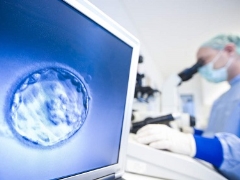IVF long protocol by day: scheme and description
The IVF protocol refers to one attempt at artificial insemination with all its mandatory steps. Generally speaking, the protocol includes preparation for ovulation or superovulation, the collection of eggs that could be “grown” by taking certain hormonal preparations. The next stage is fertilization, which occurs in the laboratory under the close supervision of embryologists. In a few days, the best and most viable of the embryos will be transferred to the woman’s womb. At this protocol as such is considered complete. The period of anxious waiting for an answer to the question begins - whether the pregnancy has come or not.
Two types of protocols are common in our country - short and long. We will tell about the long protocol in detail in this material.
What it is?
The long-term IVF protocol is a course of treatment that is prescribed by the doctor on an individual basis using well-defined hormonal agents. With this treatment regimen hormone intake starts in advance before the onset of the main cycle. And this is the main difference from the short protocol, which begins on the 3rd day of the women's cycle and ends on the 28-32th day. Hormones a woman in the short protocol takes 10-14 days to prepare the ovaries for oocyte puncture.
With a long protocol, the task is different - to get as many mature and full-fledged eggs as possible that could be fertilized. Therefore, the stage of direct hormone therapy can last up to 30 days, the protocol itself lasts on average 40-55 days.
The task of doctors who prescribe a long type protocol to a woman is to completely control all hormonal processes in her body. But first, it is necessary to suppress the natural functions of her ovaries, to cause a condition similar to menopause. Only then does follicle stimulation therapy begin, which is aimed at promoting the growth of follicles in the ovaries and eggs inside these follicles.
A long protocol is usually recommended for women whose egg quality is unsatisfactory, for women over the age of 35, as well as for women whose ovarian function is reduced. This type of treatment is suitable for women with low ovarian reserve, with endometrial disorders.
A long protocol is assigned more often than a short one. And there is a reasonable grain in this - this type of therapy allows you to simultaneously receive up to 20 oocytes, which will greatly facilitate the task of embryologists. Doctors will be able to choose the best, fertilize a sufficient number of germ cells with a higher chance of obtaining embryos of excellent and good quality.
In some cases, a woman is recommended not just a long, but an ultra-long or super-long protocol, in which hormonal substances will be administered in small doses over several months. Cumulative action will achieve good results.
There are quite a few varieties of long IVF protocols, they differ in the preparations that are used, and the time of therapy. She cannot choose a certain woman herself, since this is the exclusive right of her attending physician, who will focus on the cause of infertility, on comorbidities, and also on possible risks to the patient's health.
Advantages and disadvantages
The main advantage of a long treatment regimen for IVF is a higher probability of pregnancy. Due to the long hormonal therapy, it is possible to obtain a sufficient number of oocytes, and then viable embryos, which are more likely to be implanted in the uterus after embryo transfer.
The long protocol allows you to “stock” a supply of eggs and embryos that can be cryopreserved and then stored in a cryobank. This means that if the current protocol fails, the woman after the recovery period will be able to use this reserve for subsequent attempts. Even if the current attempt is successful, she will be able to return to the clinic in a few years and use frozen oocytes and embryos for IVF to give birth to her second or third baby. At the same time, it is no longer necessary to take hormones for a long time, puncture follicles and everything that is not too easily tolerated by the female body.
The minus the long protocol, as you may have guessed, is the length of the hormonal preparation and stimulation periods. Preparations that are used for these purposes, deliver a deafening blow to the work of all organs and systems. Women for the most part are quite difficult to tolerate long protocols - their well-being deteriorates, their weight increases, and chronic diseases can worsen. The risk of ovarian hyperstimulation syndrome and their subsequent exhaustion is quite high.
Who is shown?
Long protocols in one form or another are primarily recommended for women which have the following diseases and conditions:
- myoma;
- polycystic ovary syndrome, cyst-like formations in the gonads;
- moderate to severe forms of endometriosis;
- complete obstruction of the fallopian tubes;
- absolute absence of the fallopian tubes;
- the predominance of androgens (male-type hormones);
- high values of LH (luteinizing hormone) due to age-related changes in the functions of the sex glands or due to severe endocrine disorders;
- age factor - after 40 years;
- poor quality of the eggs, which does not allow to get strong and strong embryos or not allow to obtain embryos in general.
In addition, women who have already completed a short protocol that was unsuccessful were also recommended to replace the treatment regimen with a longer type. Quite often, this is a good solution, and pregnancy occurs.
Contraindications
The long protocol type will not apply if a woman has the following conditions and diseases:
- mental illness that requires regular or systematic psychoactive substance therapy;
- the absence of the uterus or such anatomical defects that do not allow to bear the child;
- oncological diseases, including in the anamnesis;
- diseases of the cardiovascular system;
- diabetes;
- thyroid disease.
Often the protocol is carried out according to a long type, but a woman is warned that the probability of success will be significantly lower than the baseline.
Usually a long protocol increases the likelihood of pregnancy from the base 35% to 40-45%, but with certain disorders in the body, the chances are lower:
- prolonged chronic inflammatory processes of the pelvic organs, poorly treatable by other means and methods;
- earlier operations on the uterus;
- scanty ovarian reserve, in which it is impossible to achieve a sufficient number of oocytes even in an ultra-long protocol.
Also, the probability of success is reduced if the partner is not the best spermogram.
Main steps
In general, the IVF scheme in a long protocol is not much different from the usual scheme, all the main stages in it correspond to the standard ones.The difference lies only in the preparatory stage - the stage of preparing the ovaries and taking their work under full medical supervision.
Entry into the classic long protocol occurs approximately two weeks before the onset of the next menstruation. At this stage, when all the main examinations and analyzes have already been left behind, the woman is recommended drugs that suppress the work of the ovaries, for example, Decapeptil. This drug inhibits pituitary activity.
This is followed by a stage of follicle stimulation. To do this, use other drugs that allow follicles to grow and mature faster. The whole process is monitored by ultrasound - a woman visits the doctor every two or three days so that he can see what the ovaries respond to hormonal stimulation. If follicles grow too fast, hormone doses are reduced, if growth is slow and sluggish, the dose may be increased reasonably. When the doctor states that several follicles have matured, a puncture is prescribed. Before it, 36 hours of hCG preparations are injected, this is necessary for accelerated maturation of the eggs, since the production of immature oocytes will not be beneficial - such germ cells cannot be fertilized.
The puncture itself is performed in the clinic under anesthesia, since this procedure is rather painful. Its essence lies in the puncture of the follicles with a long needle, inserted under the vigilant control of the ultrasound sensor through the wall of the vagina into each follicle in turn. There is an aspiration of the contents of each of the follicles. Liquid with eggs in a special container is delivered to the laboratory for cleaning and fertilization.
After a few days (3 or 5), a woman will be offered to come to a clinic for replanting embryos. It is important that not only good embryos are obtained, but also the woman's body is ready to receive them - the doctor must get into the so-called “implant window” - the period most favorable for implantation.
Embryoporis is not painful, it takes no more than five minutes. A defined and agreed number of embryos is transferred into the uterine cavity using a thin flexible catheter inserted through the cervical canal into the uterus.
A woman receives progesterone support until pregnancy is determined 2-3 weeks after transplantation. In the future, the feasibility of taking progesterone drugs is determined by an obstetrician-gynecologist, taking into account the peculiarities of the course of pregnancy. If there is a threat of interruption, a woman can be given progesterone up to the 16-18 week of pregnancy.
If the protocol fails and the pregnancy does not come, recovery from aggressive hormone therapy for at least 3 months is recommended. Only then can a woman become a member of the IVF program again.
Detailed scheme
Women are often interested in what the long protocol will be by day. Let's try to tell about it in more detail:
- The stage of blocking the ovaries and pituitary begins on the 20-25 day of the cycle. Prescribed medications that a woman will take according to the schedule and in the dosage that the doctor will recommend.
- The follicle stimulation stage begins on the 3-5th day of the cycle, after the blocking stage. Which drug is more effective, the doctor will decide. Most of them have injectable release forms. A woman will have to take subcutaneous or intramuscular injections every day at the same time.
- Triggers ovulation. HCG is administered when the follicles reach sizes from 18 to 22 mm according to ultrasound.
- Egg collection. It occurs exactly 36 hours after the use of ovulation triggers, otherwise there is a risk of spontaneous ovulation. At the same time, the partner delivers the sperm for fertilization.
- Fertilization and embryo assessment, cultivation - within 3-5 days after fertilization.
- Embryo replanting (the term is set by the doctor).
If all stages are successfully completed, it remains only to have patience and wait 2 weeks.After this period, a woman is recommended to do a blood test for hCG for the first time, and on day 21 after the embryo-transfer took place, the first diagnostic confirmatory ultrasound is done with a positive or doubtful blood test for hCG.
If a long protocol is appointed, it means that a woman is not expected to have the easiest half to two months, during which she will need maximum strength, patience and performance - success largely depends on how well a woman will follow all the recommendations and doctor's prescriptions. at each stage of the IVF treatment cycle.
Wellbeing
In the course of a long protocol, some women feel almost unchanged, but such representatives of the fair sex can be counted on fingers. Most often, certain changes do occur. At the stage of blocking the ovaries, the woman feels the full range of sensations that usually accompany menopause - “hot flashes” and dizziness, headaches, migraines, and increased irritability. She becomes psychologically and emotionally unstable, nervous, and tearful. At this stage it is quite difficult to maintain good relations with others and go to work.
At the follicle stimulation stage, women often complain of a feeling of abdominal bloating, bloating and flatulence, nausea, sleep disturbances and mood swings, as well as engorgement and discomfort in the mammary glands. Unfortunately, these are the effects of hormones, their side effects. The aching pain in the lower abdomen is associated with an increase in the ovaries, because in the long protocol, they have matured significantly more eggs than it does in the natural cycle.
It is not necessary that the state of health be very bad. Everything is quite individual. But with a sharp deterioration, a woman will definitely need to consult a doctor and, possibly, a drug replacement or dose adjustment.
Reviews
The most painful, according to women, is the need to make injections on their own. At the same time, after subcutaneous administration, huge bruises appear on the abdomen, which also hurt. Most fertility specialists do not allow a woman who is in a long protocol to take herbs and sedatives for sedation, and constant irritation is very difficult for both the woman and everyone around her.
There is a higher cost of a long protocol compared to the cost of a short one. The cost of IVF is different due to the fact that most of the cost consists of the price of drugs, and hormonal drugs are very expensive. If IVF is done by quota, the difference between the quota funds and the real clinic account can reach amounts above 120 thousand rubles, you need to be prepared for this to avoid unpleasant surprises.
Some women, who entered into a long protocol after an unsuccessful short, note that the chances of pregnancy did not increase significantly. The response of the ovaries to a longer stimulation is not always more productive, and doctors, alas, cannot give guarantees.
Reviews of those who got pregnant, grateful and enthusiastic, because this difficult way gave them a baby.
See the following video from Boris Kamenetsky’s “Just About IVF” answer cycle in the following video from the “Just About IVF” response cycle.





























